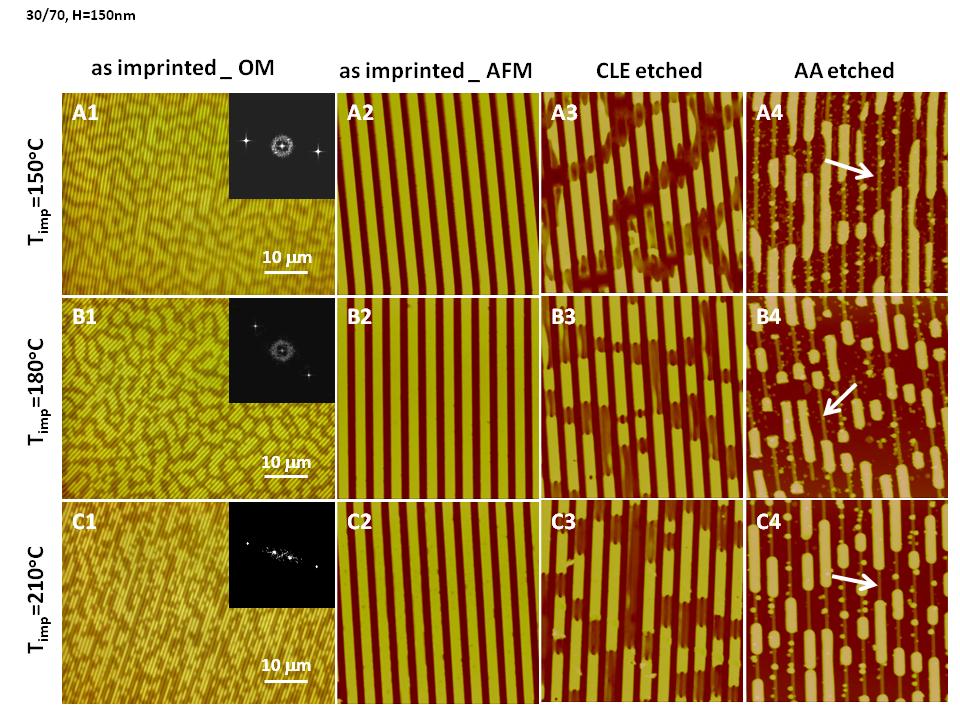www.acsprf.org
Reports: DNI750581-DNI7: Phase Separations and Morphological Evolutions of Polymer Blends under Two Dimensional Confinements
Yifu Ding , University of Colorado at Boulder
This work seeks to elaborate the phase separation and morphological evolutions of polymer blends under 2D confinements that are beyond current knowledge of thin film polymer blends. Particularly, we aim to understand the influences of preferential wetting of constituent polymers and physical confinements on the phase diagrams and the morphological evolutions. We have developed a novel approach to use Nanoimprint Lithography (NIL) to impose the physical confinements onto immiscible polymer blends. NIL is a low-cost, accessible lithographic technique with sub-10nm patterning resolution, which mechanically drives the polymer blend film into the nanoscale features. The physical confinement of the cavities walls from the template is significantly stronger than that in the planar thin films, which will dictate the phase separation and morphological evolutions such as domain breakup or coarsening.
Thus far, PS (MW=190kg/mol) and PMMA (MW=94kg/mol) blend films were used for the study. We examined the morphology of the PS/PMMA blend nanopatterns obtained from NIL, with systematic variations in (1) imprinting temperature (Timp, or the coarsening temperature for the confined blend), (2) composition, and (3) thickness of the blend films. All the temperatures involved here are within the two phase region of the PS/PMMA phase diagram for the given molecular weights, and thus the later stage of phase separation, i.e., the coarsening/segregation behaviors are examined here. The details can be found in ref. 1.
For all the different compositions of PS/PMMA examined, we discover that the coarsening process of the PS/PMMA domains are mostly driven by the segregations of the PMMA towards the SiOx surfaces of both the confining channel walls (from the template) and the Si substrate. This is significantly different from planar blend films and bulk samples where the interfacial coarsening is the major driving force. Such selective segregation of PMMA creates a series of interesting blend nanostructures: topographically uniform by chemically heterogeneous. As an example, Fig. 1 shows the morphology of the 30/70 PS/PMMA blend film after being imprinted at varying temperatures, determined by optical microscope (left) and AFM on as-imprinted pattern, after removal of PS by Cyclohexane (CLE) and PMMA by Acidic acid (AA). All AFM images in Fig. 1 are 10 mm x 10 mm. With increase of Timp, the coarsening kinetics is noticeably faster due to the enhanced mobility, and the intrinsic bi-continuous phase structures in the as-casted PS/PMMA film started to break more drastically at higher Timp. At the same time, the residual layer becomes increasingly occupied by the PMMA, which isolates the PS into capsule-like domain within the channels (Fig.1). For example, at Timp=210 oC, the residual layer has been completely occupied by the PMMA.
Figure 1
Similar morphological evolution was observed for the patterned 50/50 and 70/30 PS/PMMA films, where PMMA domains within the lines gradually coalesce with the residual layer and drove the original continuous PS matrix into encapsulated blocks within the line. The surface coverage of the PS along the lines decreases simultaneously. This creates a phase inversion in the patterned PS/PMMA blends, i.e. the original continuous major phase, PS, evolve into isolated phase. Intriguingly, the encapsulated block morphology formed via anisotropic growth of the PMMA domain in the 50/50 pattern is similar to that developed via anisotropic breakup of the PMMA domain in the 30/70 pattern. Presently, it is unclear whether such morphology represents a meta-stable state, particularly when compared to the core-shell like morphology.
Our experimental results clearly demonstrate the dominant role of preferential wetting and physical confinement on the morphological evolutions of the confined polymer blend, which leads to a range of unique topographically uniform and chemically heterogeneous patterns. This offers unique capability and potential to directly pattern a range of functional materials using NIL on polymer blends. Up to now, neat polymers have been widely used in the NIL fabrication. However, neat polymers are intrinsically limited by their chemical and physical characteristics. Multifunctional polymer nanostructures with a combination of topographic features and diverse chemical functionalities are critical to many emerging technologies. Mixing or blending polymers has been a traditional processing strategy to improve the properties of the neat polymer materials in bulk. Our preliminary study shows that it may also be a viable approach to fabricate chemically heterogeneous nanostructures using NIL.
1. Zhen Wang, Dae Up Ahn, and Yifu Ding, “Topographically Uniform but Chemically Heterogeneous Nanostructures by Nanoimprinting Demixed Polymer Blends”, Langmuir 2010, 26, 14909-14914.

